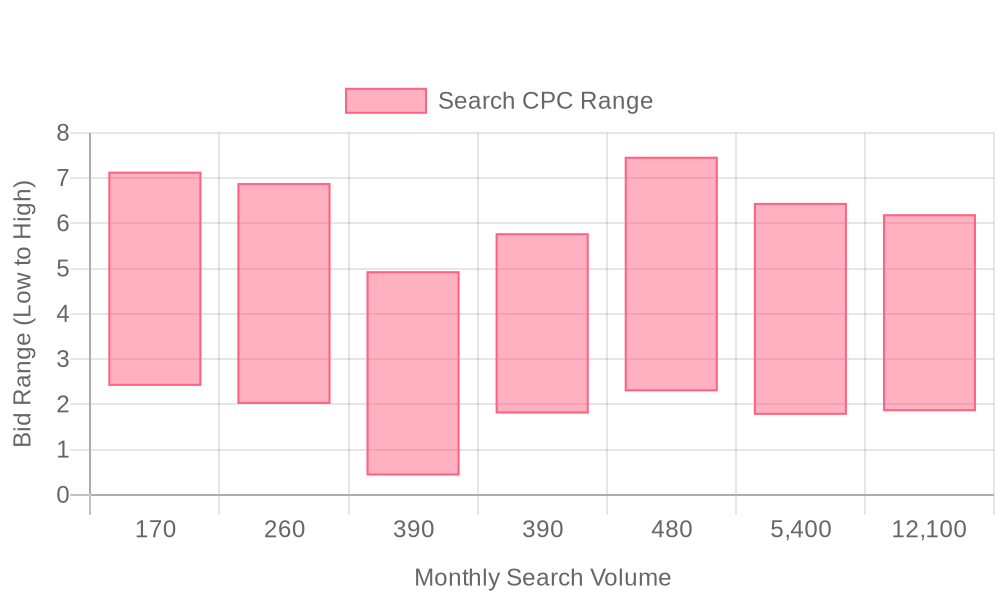
Supercharge your lead generation with a FREE Google Ads audit - no strings attached! See how you can generate more and higher quality leads
Get My Free Google Ads AuditFree consultation

No commitment
Supercharge your lead generation with a FREE Google Ads audit - no strings attached! See how you can generate more and higher quality leads
Get My Free Google Ads AuditFree consultation

No commitment
In the evolving landscape of Direct Primary Care, efficient patient acquisition requires a multifaceted marketing approach. Challenges such as lack of visibility into patient interest can hinder growth, as potential leads remain unknown and untapped. Google Ads serve as a pivotal tool to capture potential patients actively searching for healthcare solutions. They bridge the awareness gap created by broader marketing efforts and offer a targeted method for connecting with patients at their moment of need. Leveraging Google Ads allows Direct Primary Care clinics to reach a precision audience with specific calls to action, converting online interest into tangible patient engagements at the clinic level.

Direct Primary Care providers face unique challenges in patient acquisition due to the subscription-based model and the need to educate consumers about non-traditional healthcare options. Deploying Google Ads with a precise, data-driven strategy addresses these challenges by surfacing the DPC value proposition to high-intent searchers and local audiences looking for better primary care solutions. For a step-by-step breakdown, review this guide to launching Google Ads for healthcare providers.
Modern revenue teams leverage advanced search and audience intelligence to move beyond guesswork, focusing their Google Ads budget for healthcare on the prospects with the greatest likelihood of conversion. By integrating tools that can identify anonymous website visitors, marketers transform previously lost web traffic into actionable lead data, ensuring every advertising dollar works harder to drive new patient signups.
Developing a search strategy anchored in real-time data allows practices to capture in-market activity as it happens. When healthcare buyers actively compare DPC to traditional insurance or search for local providers, the ability to dynamically shift budget and bids ensures ads appear for the most valuable queries. For additional strategies, explore this comprehensive guide to effective marketing for direct primary care.
Effective targeting avoids generic messaging and instead segments audiences by intent, geography, and healthcare needs. Utilizing platforms that update audiences in real time as prospects engage or move through the funnel enables DPC marketers to maintain relevance and reduce wasted impressions. This ensures that campaigns remain focused on those most likely to convert, improving Google Ads ROI for clinics.
Landing pages and creative assets must deliver a seamless, patient-centric journey that reinforces trust and explains the DPC model clearly. Aligning each ad group’s messaging with its landing page, while keeping calls to action and pricing information prominent, eliminates friction and raises conversion rates. Advanced lead enrichment and attribution make it possible to track consult bookings or signups, tying Google Ads setup for medical practices directly to new membership revenue.
Continuous optimization relies on unified data to reveal which campaigns, keywords, and audience segments drive the best results. With a comprehensive view of both online and offline conversions, teams can identify underperforming assets, reallocate budget, and test new creative rapidly. This iterative process is critical to Google Ads best practices for healthcare, where compliance and patient trust are paramount.
Integrating Google Ads data across CRM and other marketing platforms closes attribution gaps, enabling precise measurement from first click to patient onboarding. Syncing enriched leads and audiences into platforms like HubSpot or Salesforce ensures sales and care teams have the context they need to personalize engagement, increasing retention and referral rates. This cross-channel integration empowers DPC practices to streamline demand generation and improve the overall efficiency of their online marketing for Direct Primary Care. To see how seamless data integration can transform your lead generation, get started for free with Sona.

Direct Primary Care practices operate in a landscape defined by complex patient needs, competitive markets, and limited brand awareness. Google Ads offers a direct path to connect with individuals actively seeking healthcare solutions, ensuring marketing budgets target those with immediate intent to book appointments or learn more about membership models. This channel eliminates wasted spend on uninterested audiences, focusing outreach on prospects already evaluating care options—see this step-by-step guide on launching effective Google Ads campaigns tailored for healthcare providers for a deeper look at proven strategies.
Precision targeting stands out as a core advantage. By leveraging search intent, DPC clinics capture high-value patient leads who are dissatisfied with traditional insurance-based care or have urgent health concerns. This reduces the risk of losing interest from prospects who might otherwise delay decisions or be drawn to competing providers. Real-time data from Google Ads empowers practices to respond instantly to spikes in demand or shifts in local healthcare needs, especially when combined with real-time audience segmentation for tailored outreach.
Cost efficiency is another critical benefit for Direct Primary Care marketing. Instead of relying on broad, expensive campaigns, Google Ads lets clinics allocate budget toward regions, demographics, or search behaviors most likely to convert. This granular approach enables smaller clinics to compete with established providers and quickly fill appointment slots. Region-specific visibility also helps DPC practices expand into underserved communities or test new locations without overcommitting resources; explore more actionable marketing playbooks for additional strategies.
Integrated analytics resolve the disconnect between marketing and patient acquisition. Every click, call, and form submission is measured, revealing which ads, keywords, and audiences drive consultations and new memberships. When revenue teams unify Google Ads data with downstream CRM or patient management systems, they not only see which campaigns produce the highest ROI but also enrich future targeting. This continuous feedback loop supports smarter allocation, higher conversion rates, and a more predictable growth engine for Direct Primary Care practices. Ready to experience this advantage? Get started for free with Sona.


Direct Primary Care practices unlock faster growth by targeting channels and tactics that reach patient segments actively seeking alternatives to traditional insurance-based care. Growth is accelerated when marketing investments are directed at high-intent audiences and engagement is tailored to patient concerns, not generalized assumptions. By focusing on precision and relevance in every campaign element, practices consistently outperform average industry conversion rates and achieve sustainable patient acquisition.
For practices ready to operationalize these strategies and accelerate patient acquisition, get started for free with Sona.

Effective audience segmentation for Direct Primary Care (DPC) transforms digital marketing from a broad broadcast into a targeted, patient-centric experience. By understanding and acting on each segment’s needs and readiness, healthcare marketers can optimize engagement, improve conversion rates, and maximize their Google Ads budget for healthcare. For more strategies on data-driven targeting, explore our marketing analytics blog.

| Industry | Keyword | Monthly Search Volume | Competition Level | Low Bid | High Bid |
| Direct Primary Care | direct pay doctors near me | 170 | LOW | 2.41 | 7.14 |
| Direct Primary Care | direct care provider near me | 260 | MEDIUM | 2.01 | 6.89 |
| Direct Primary Care | dpc healthcare | 390 | LOW | 0.43 | 4.94 |
| Direct Primary Care | direct primary care model | 390 | LOW | 1.8 | 5.78 |
| Direct Primary Care | direct care provider | 480 | LOW | 2.29 | 7.47 |
| Direct Primary Care | direct primary care near me | 5400 | LOW | 1.77 | 6.45 |
| Direct Primary Care | direct primary care | 12100 | LOW | 1.85 | 6.2 |
Direct Primary Care practices must compete on specificity and intent, not volume. The most effective Google Ads strategies leverage intent-first keywords that identify prospects actively searching for healthcare alternatives and subscription-based primary care. By applying predictive scoring to keyword planning, marketers can allocate budget to segments already showing strong conversion potential, rather than casting a wide net and hoping for results.
Adding local and service-specific modifiers, such as geographic regions, nearby neighborhoods, or specialty offerings, further narrows the audience to those most likely to convert. For example, targeting phrases like “direct primary care in [city]” or “monthly primary care membership near me” increases relevance and drives higher-quality leads. This approach is especially important for DPC practices, where proximity and trust are primary decision factors for patients. For a step-by-step approach to launching effective campaigns, consult this Google Ads guide for healthcare providers.
Negative keyword lists are essential to protect budget and ensure ads are only shown to those seeking care, not job seekers or unrelated traffic. By filtering out searches for “insurance jobs,” “Medicare eligibility,” or “free health clinics,” practices prevent costly impressions that will never convert. This level of precision is only possible when marketers unify search data with downstream engagement metrics, continuously refining negative lists based on real patient behavior.
Regional nuances and hyper-local needs should guide keyword grouping and campaign structure. Using data-driven segmentation, DPC marketers can build clusters for neighborhoods, employer groups, or high-growth communities, aligning ad copy and offers to local context. When audience identification technology is layered in, marketers move beyond anonymous clicks to pinpoint which companies or households are engaging, prioritizing outreach to those accounts that show in-market activity for healthcare services.
Sample target terms for Direct Primary Care include:
By grouping these keywords based on predictive value and regional context, marketers can deploy dynamic audiences that update as leads move through the consideration funnel. This enables timely retargeting, more accurate lookalike modeling, and a closed-loop view of which search terms drive booked consultations and patient acquisition. When this system syncs with CRM and ad platforms, every touchpoint—online and offline—contributes to a unified ROI measurement, revealing the true impact of each keyword investment on clinic growth. To experience this data-driven approach, get started for free with Sona.
A systematic campaign execution framework ensures that Direct Primary Care practices extract maximum value from their Google Ads investments. With the right blend of strategy and technology, providers can engage high-intent patients, deliver relevant messaging, and track ROI at every step of the funnel. Modern marketing teams thrive when every tactic is rooted in actionable data and unified workflows. To see how unified data powers smarter campaigns, explore these actionable marketing playbooks.
Effective keyword selection anchors the success of Direct Primary Care advertising. Marketers start by researching terms that reflect patient intent, such as "direct primary care near me," "monthly doctor membership," or "affordable family healthcare." Localized modifiers, including neighborhood names or city-specific queries, attract searchers actively seeking care options in their area. For a step-by-step approach tailored to healthcare providers, this launch guide for Google Ads in healthcare offers practical insights.
As new search data emerges, advanced platforms help surface granular intent signals that generic tools often miss. Teams can identify not just which keywords drive clicks, but also which terms indicate true patient readiness. By continuously syncing live search intent with campaign lists, marketers keep their keyword targeting precise, relevant, and responsive to changing patient needs.
Ad copy for Direct Primary Care must address real-world pain points with clarity and empathy. Messaging that highlights time savings, transparent costs, or direct access to physicians resonates deeply with prospective patients. Strong calls to action, such as "Book a Free Consultation" or "See Monthly Pricing," move prospects closer to conversion without relying on vague promises. For more inspiration, review practical tips for Google Ads for doctors to sharpen your copywriting.
Continuous improvement in ad messaging becomes possible when marketers receive real-time audience feedback on which copy variants drive engagement and appointments. As audience intent shifts or new benefits gain traction, agile teams quickly update ad creative in sync with audience data. This dynamic test-and-learn approach ensures consistently high relevance and conversion rates.
The landing page is where interest translates into action. For Direct Primary Care, each landing page must reinforce the unique value proposition—unlimited visits, no insurance hassles, and easy sign-up. Patient-centric layouts, concise explanations of the DPC model, and streamlined forms reduce friction and encourage appointment bookings. To maximize ROI, review guidance on high-converting healthcare landing pages.
Integrated campaign technology makes it possible to personalize landing experiences for each visitor segment. When marketers recognize returning prospects or specific company accounts, they can dynamically tailor content, highlight relevant testimonials, or offer exclusive incentives. This level of personalization reduces bounce rates and elevates the likelihood of a completed appointment request.
Optimization is not a one-time task but an ongoing discipline. Marketers monitor critical performance metrics, such as cost-per-consultation and conversion rates, to identify opportunities for incremental gains. Regular analysis of keyword performance, ad engagement, and landing page activity informs iterative improvements, as outlined in ten essential PPC tips for healthcare.
With unified campaign analytics and online/offline conversion tracking, teams can attribute patient enrollments back to specific ad interactions. When new data streams in, lead and audience segments update in real time, allowing for automated budget shifts toward campaigns with the highest return. This closed-loop approach ensures every dollar spent on Google Ads for Direct Primary Care is continually working to drive measurable patient acquisition and revenue growth. Ready to improve your results? Get started for free with Sona.
Expanding a Direct Primary Care clinic’s presence in today’s market requires a multi-layered digital strategy that delivers timely, relevant messaging at every stage of the patient journey. Clinics that leverage real-time audience data and actionable insights consistently outperform those relying on generic outreach or single-channel tactics. For a deeper dive into top marketing strategies for direct primary care, this overview of best marketing strategy for direct primary care offers useful tactics for increasing patient sign-ups.
Promoting high-value content assets through remarketing is essential for reinforcing patient engagement and reducing the time between initial interest and conversion. By deploying retargeting ads to audiences who have already interacted with your clinic’s website or downloaded educational resources, you keep your brand top-of-mind. Platforms that reveal which companies and people are visiting your website empower your clinic to prioritize outreach to high-value prospects and tailor follow-up for more booked appointments and higher patient acquisition rates.
Focusing on state or metro-specific targeting allows Direct Primary Care clinics to achieve dominant visibility in high-priority regions. Predictive models help optimize budget allocation toward geographies with the most in-market patients, while dynamic audience updates ensure your campaigns keep pace with shifting local demand. As your audience segments evolve—such as leads moving from consideration to decision stage—your targeting adapts in real time, ensuring ads and offers remain relevant and compelling for each prospect. Explore additional actionable playbooks in our marketing playbook library.
Partnering with healthcare associations unlocks co-marketing opportunities that expand both reach and credibility. Collaborative campaigns with trusted organizations can drive significant referral traffic and build trust with skeptical patient segments. By integrating association-sourced leads into your Google Ads audiences and CRM, you can nurture these high-quality prospects across both paid and owned channels, driving measurable increases in patient sign-ups and boosting long-term ROI from your digital marketing investments. To streamline your digital campaigns and audience targeting, get started for free with Sona today.
Mastering Google Ads can be a game-changer for your Direct Primary Care practice, offering innovative ways to attract and retain patients in a competitive healthcare landscape. By leveraging targeted ad strategies, you can effectively reach potential patients who are seeking personalized and accessible care solutions.
Throughout this article, we've explored the unique challenges faced by Direct Primary Care providers when navigating Google Ads. From understanding the importance of precise keyword targeting to crafting compelling ad copy that resonates with potential patients, these strategies equip you to drive engagement and grow your practice sustainably.
Imagine the transformation of your practice as you implement these strategies, creating a steady stream of patients who value your approach to healthcare. With each step, you're not only enhancing your practice's visibility but also building a loyal patient base that appreciates the distinctive care you offer.
Take the next step in revolutionizing your Direct Primary Care practice. Start for free to experience our platform and its capabilities today, and see firsthand how data-driven insights can elevate your advertising efforts.
Best practices include leveraging real-time data for precision targeting, creating patient-centric landing pages, and aligning ad messaging with patient needs to maximize conversions and ROI.
Effectively targeting patients involves using audience segmentation based on intent, geography, and healthcare needs, and continuously updating these segments in real-time to maintain relevance.
The budget should be dynamically allocated based on search behaviors, demographic data, and real-time insights to focus on high-conversion prospects, ensuring cost efficiency and maximizing ROI.
Keywords should reflect patient intent and include local modifiers, such as 'direct primary care near me' or 'monthly doctor membership,' to attract high-quality leads actively seeking care.
Success is measured by tracking key actions like consultation bookings and new memberships, integrating Google Ads data with CRM systems for comprehensive online and offline attribution.
Join results-focused teams combining Sona Platform automation with advanced Google Ads strategies to scale lead generation

Connect your existing CRM

Free Account Enrichment

No setup fees
No commitment required

Free consultation

Get a custom Google Ads roadmap for your business
Join results-focused teams using Sona Platform automation to activate unified sales and marketing data, maximize ROI on marketing investments, and drive measurable growth

Connect your existing CRM

Free Account Enrichment

No setup fees
No commitment required

Free consultation

Get a custom Google Ads roadmap for your business
Over 500+ auto detailing businesses trust our platform to grow their revenue
Join results-focused teams using Sona Platform automation to activate unified sales and marketing data, maximize ROI on marketing investments, and drive measurable growth

Connect your existing CRM

Free Account Enrichment

No setup fees
No commitment required

Free consultation

Get a custom Google Ads roadmap for your business
Over 500+ auto detailing businesses trust our platform to grow their revenue
Join results-focused teams using Sona Platform automation to activate unified sales and marketing data, maximize ROI on marketing investments, and drive measurable growth

Connect your existing CRM

Free Account Enrichment

No setup fees
No commitment required

Free consultation

Get a custom Google Ads roadmap for your business
Over 500+ auto detailing businesses trust our platform to grow their revenue
Join results-focused teams using Sona Platform automation to activate unified sales and marketing data, maximize ROI on marketing investments, and drive measurable growth

Connect your existing CRM

Free Account Enrichment

No setup fees
No commitment required

Free consultation

Get a custom Google Ads roadmap for your business
Over 500+ auto detailing businesses trust our platform to grow their revenue
Our team of experts can implement your Google Ads campaigns, then show you how Sona helps you manage exceptional campaign performance and sales.
Schedule your FREE 15-minute strategy sessionOur team of experts can help improve your demand generation strategy, and can show you how advanced attribution and data activation can help you realize more opportunities and improve sales performance.
Schedule your FREE 30-minute strategy sessionOur team of experts can help improve your demand generation strategy, and can show you how advanced attribution and data activation can help you realize more opportunities and improve sales performance.
Schedule your FREE 30-minute strategy sessionOur team of experts can help improve your demand generation strategy, and can show you how advanced attribution and data activation can help you realize more opportunities and improve sales performance.
Schedule your FREE 30-minute strategy sessionOur team of experts can help improve your demand generation strategy, and can show you how advanced attribution and data activation can help you realize more opportunities and improve sales performance.
Schedule your FREE 30-minute strategy session





Launch campaigns that generate qualified leads in 30 days or less.
